In 2012 the Moscow City Government issued a rule, calcified into law in 2019, which caused a certain amount of buzz amongst the creative classes. The rule was a stern reminder to “respected Muscovites and guests of the capital” that roasting meat on the city’s residential balconies was neither allowed nor encouraged. That it came around the Muslim holiday of Eid-al-Fitr was no coincidence, which led many to conclude that the announcement was addressed more to guests of the capital, whose numbers included many Central Asian migrant workers, than it was to the respected Muscovites.
I was reminded of this after a grainy Zoom catch-up with a colleague who was regretting his decision not to decamp to his dacha when he still could. Cold weather and lack of heating made his dacha unwise back in early March, but with warmer weather now on the horizon, he’s pining for the quieter life of the dacha, and its cuisine.
The grass is always greener; they say. Half of my cyber cohort are coping with COVID-19 lockdown in large metropolitan areas. They live on sanitized take out, attend grainy Pilates classes via Zoom, and slink out for occasional furtive forays to a backdoor beauty salon or bootleg manicurist. The other half, who scurried out to their dachas before QR-code regime began, are weathering the frigid weather with less-than-adequate heating. They have run out of reading materials and are now bored out of their minds, even with the now ubiquitous #quarantinepuppy.
The former group pines for fresh air, whereas the latter would sell their babushkas for a halfway decent Chinese takeaway and better Wi-Fi connectivity.
The dachniki have one matchless advantage: the barbeque. As we swing into June, it is high time to bring cooking out to the open air and enjoy the slower, simpler dacha cuisine. As a member of the weaker sex, I always welcome grilling season with relish; all I need do from June – September is give raw meat an 8-12-hour bath in acid, salt, and aromatics and make a few complimentary sides. I don’t even care if my husband takes all the credit. Let them ooh and ahh; I’ve clawed back hours of free time.
Shashlyk, like spices and fermentation, is a gift to the Russians from the Tatar Mongols, who swept across the plains of Eurasia in the late 13th century and occupied the lands of Rus for over 200 years. They built an empire that at its peak stretched from Poland to China, and to do that, they were always on the move, as restless as they were ambitious, permanent nomads on their well-trained horses.
Shashlyk may have its roots in the Middle East and Asia, but it’s now as much the fulcrum of summer dining in the outskirts of Voronezh as it is in the bazaars of Ulan-Bator. And is it any wonder? The smell of sizzling lamb or pork mingled with wood smoke and just a hint of mown hay is more than enough to get the salivary glands working.
But can you replicate shashlyk in a compact city apartment? Should you even try? In a rare moment of solidarity with the Moscow city government, I want to come out unequivocally against trying to roast a whole goat on a spit on your Moscow balcony. That’s a recipe for disaster, but if you have a halfway decent oven and a sheet pan (or a griddle pan with ridges) there is absolutely no reason to go without your skewer of grilled meat. An approximation of shashlyk is easy to replicate in a city kitchen.
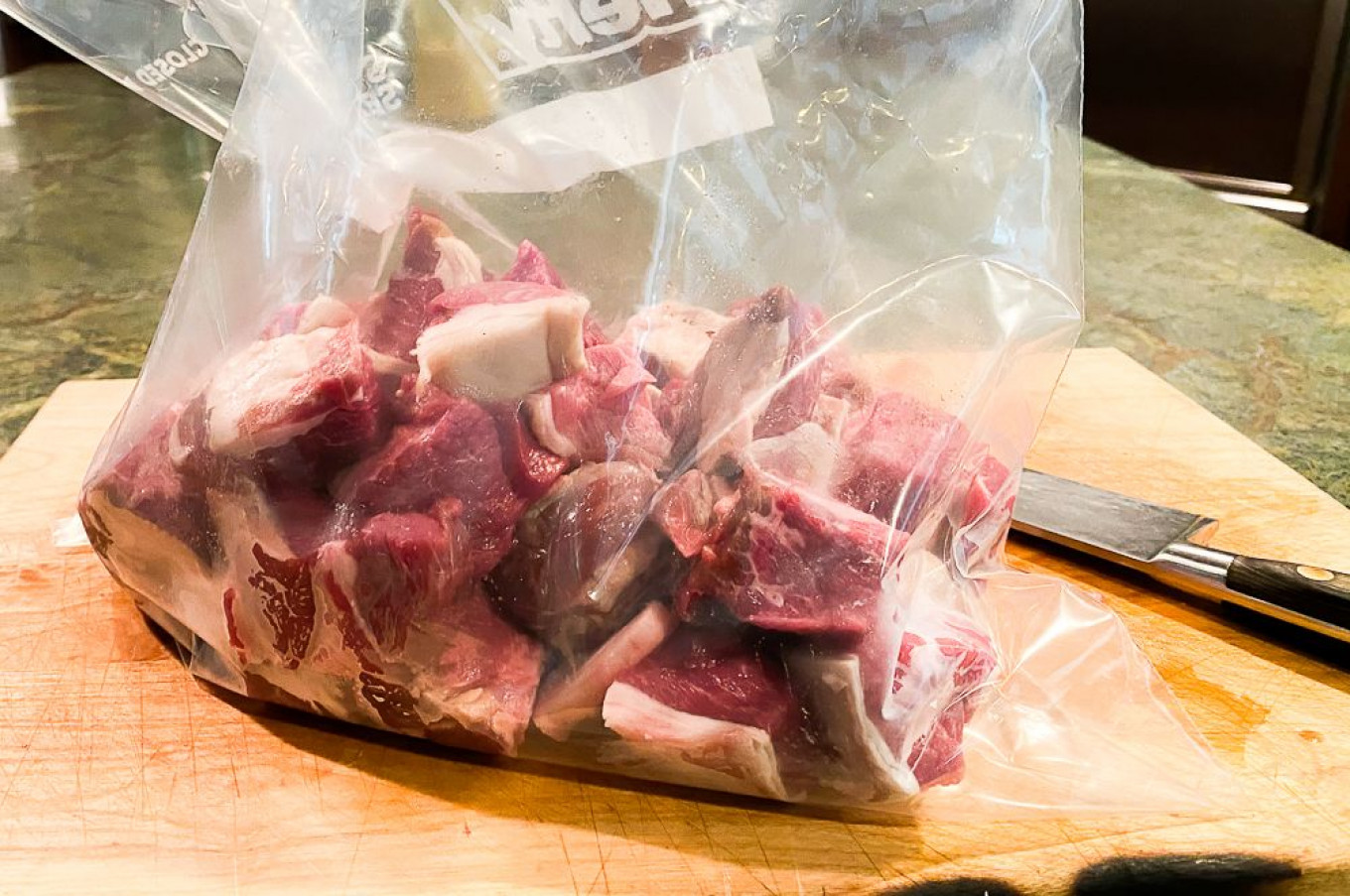
Marinate, Marinate, Marinate
The most important piece of kit for shashlyk in the city is not the broiler or the sheet pan, or even the wooden cocktail skewers soaked in saltwater. It’s the sturdy plastic bag.
The secret to great shashlyk is a robust marinade. Not only does a 12-24-hour bath in acid, salt, and herbs and spices imprint new flavors onto the fairly neutral canvas of raw meat, it also begins breaking down the meat’s protein cells. Marinated meat is far more tender and thus requires far less cooking time. Less cooking time = juicy meat.
Marinades should combine acid, salt, and flavorings. It’s the choices you make and how you combine these elements that gives each batch of shashlyk its special taste.
Acid
The best acid for lamb, beef, and game is dry red wine. And it need not be a great vintage. (I used to make an inventory of the bottles people would bring to my parties and divide them into marinade-quality and non-marinade quality).
Chicken, turkey, and pork respond well to the acid in white wine. You can also use citrus but dilute it since citrus can “cook” meat such as chicken. Orange juice and zest are brilliant additions to beef and lamb marinade, and lemon and chicken are a match made in heaven.
Another marinade acid base is kefir, buttermilk, or yogurt. It works well with lamb and chicken when paired with rasol (pickle juice). Try it once and you’ll be sold.
Salt
Salt is the key to breaking down the proteins. But remember that salt also is found in several condiments, which can do double duty in the marinade by injecting flavor. Soy sauce is an obvious example, but so is rasol, hot sauce, mustard, salsa, or even bottled salad dressing.
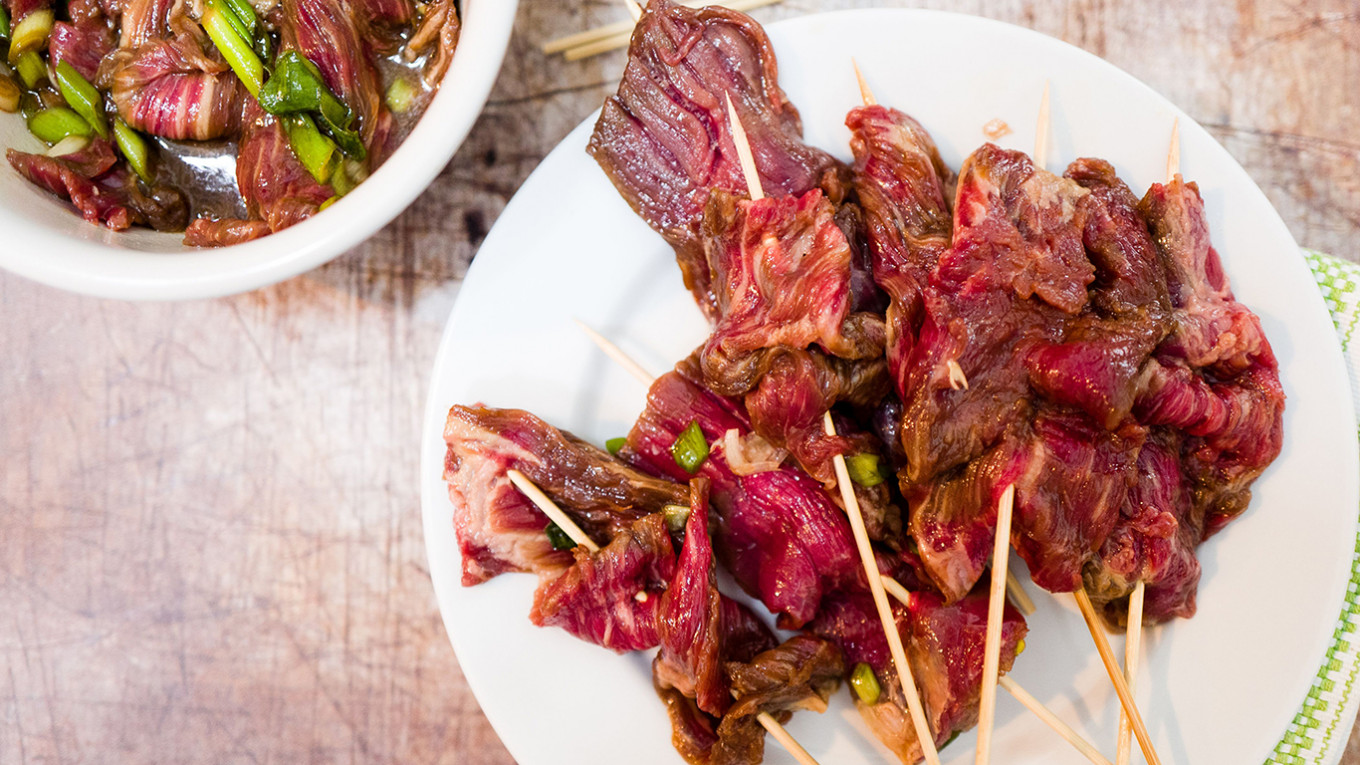
Flavor Accents
Garlic and onions add piquancy to a marinade, but don’t forget the merits of chives, shallots, leeks, or the marvelous young garlic shoots that are currently in season.
Lamb and game marinades benefit from an umami injection. My favorite way to achieve this is a couple of anchovies, but several tablespoons of Worcestershire sauce or Asian fish sauce will achieve the same effect. A dollop of tomato paste works well with beef and lamb, adding a sweet note.
Fresh herbs and dried spices are the most complicated aspect of the marinade mix. There are obvious choices: rosemary, thyme, and coriander for lamb, sweet red pepper for beef, basil and tarragon for chicken. But other spices like bay leaves, sumac, paprika, mint, cumin, juniper berries, summer savory, tarragon, and cilantro can also introduce subtle flavors to a marinade.

Cooking the Shashlyk
Always allow the meat to come to room temperature before you grill, broil, or sear it. Pour off the marinade (or save if recipe suggests serving the meat with the marinade) and pat the meat dry.
Open-fire shashlyk is always impaled on long metal skewers — usually too long for a conventional oven. The urban alternative to these is 9-12-inch wooden cocktail skewers, which should be soaked in saltwater to avoid scorching.
Sadly, neither the broiler nor the stove top can completely replicate the char of the open fire, nor can they impart the acrid accent of wood smoke or the citrusy hint of freshly mown hay.
That said, the broiler and the stovetop both offer options to give the meat what it needs: hot and intense heat. A cast-iron griddle pan with raised edges on the stovetop will give you a nice sear if the pan is hot enough. A broiler will provide intense heat from above for a quick sear if you can get the meat close enough to the heat source. Both methods require turning the meat so that each side receives an equal blast of heat.
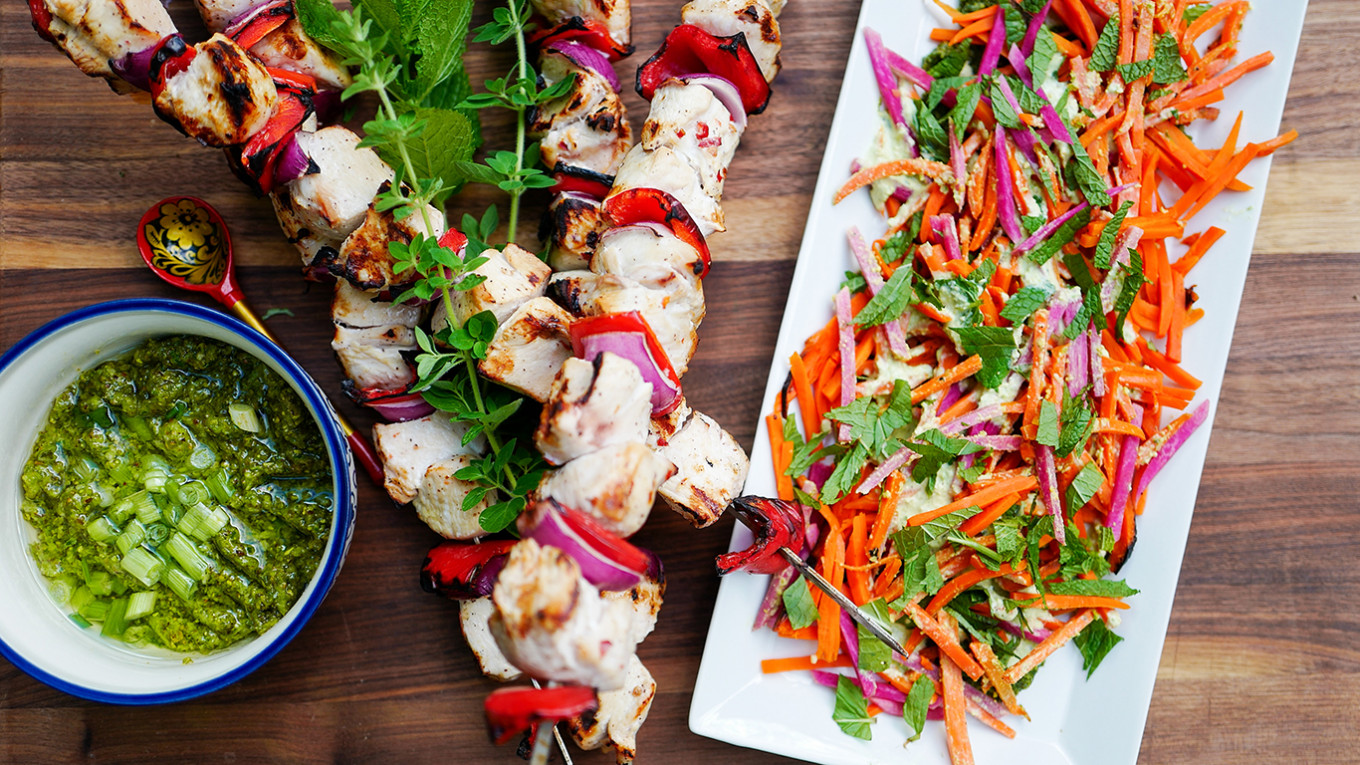
What to serve with shashlyk?
The beauty of shashlyk is that you need little alongside it. A simple salad of cucumbers and tomatoes in a light oil and lemon juice dressing is traditional, as is Central Asian flatbread. Or you could dip into The Moscow Times archive for more innovative sides.
Sauces
When there isn’t a pandemic raging, I get very tetchy when Russians produce a bottle of tomato ketchup as the preferred (sometimes the only) compliment to shashlyk. The culinary canon of the former Soviet Union offers much better options, from pungent Georgian Tkemali and adjika to the family of milder tomato and pepper condiments, which runs through Eastern Europe like a red river. But quarantine often dictates shopping in your pantry, and I encourage you to get creative with the things you have lurking in the fridge.
Makeshift Pantry Shashlyk Sauce
- Swirl mayonnaise and ketchup together with a teaspoon of horseradish and a dash of vodka for a cocktail sauce.
- Add lemon, garlic, fresh herbs, and a large tablespoon of Dijon mustard to Greek yogurt or sour cream
- Mash 1 tablespoon of capers in ⅓ cup of mayonnaise with chopped fresh herbs and a spritz of lemon juice
- Combine ⅓ cup of chopped herbs (dill, oregano, mint, basil etc.) with ⅓ cup of olive oil and the juice and zest of one lemon.
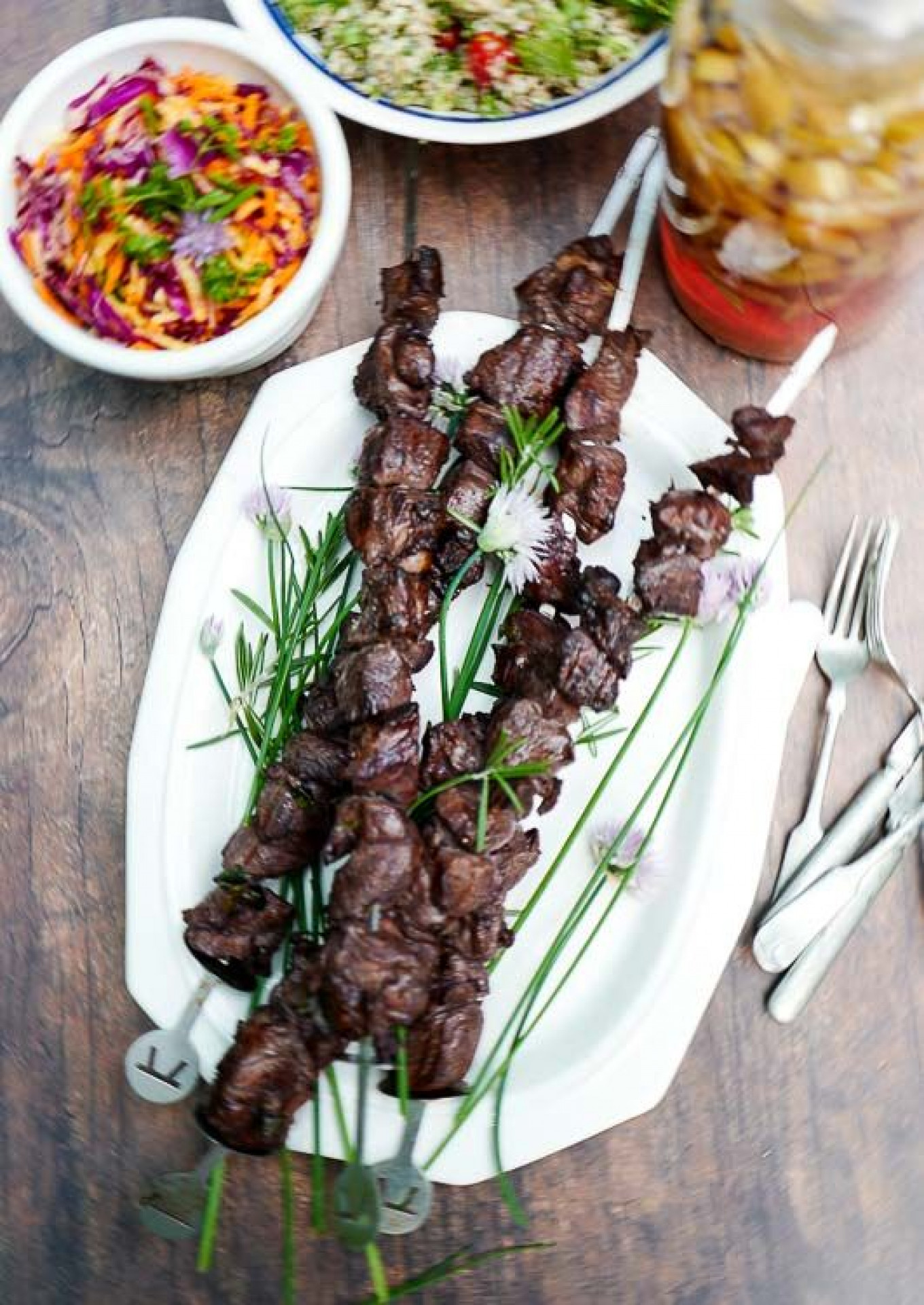
Lemon and Mustard Pork Shashlyk
Note: This recipe takes a two-step approach of brining the pork first before combining it with a marinade for a final 5-8 hours.
Ingredients
3 lbs. (1.5 kilos) pork butt or shoulder cut into 2-inch (5 cm) chunks
For the Brine
- 4 cups (1 liter) water)
- ½ cup (125 ml) salt
- ½ cup (125 ml) sugar (brown sugar will add a nice toasty note)
- 4-6 sprigs fresh thyme
For the Marinade
- ⅓ cup (80 ml) Dijon mustard
- ⅓ cup (80 ml) olive oil
- ⅓ cup (80 ml) chopped fresh basil and parsley
- Juice and zest of one lemon
- 1 tsp Aleppo pepper or several grinds of Black pepper
- 3 Tbsp salt
- 2 garlic cloves, grated with a Microplane or finely chopped
Instructions
- Place the meat and brine ingredients into a sturdy plastic bag, close securely and then shake and massage the bag to make sure the ingredients are combined. Place the bag in a bowl, or on a sheet pan, and refrigerate overnight.
- While the meat is brining, combine the remaining ingredients in a food processor fitted with a steel blade and process until smooth.
- Discard the brine and pat the meat dry. Add the marinade to the bag and massage the ingredients to disperse. Refrigerate for 5-6 hours. If you are short on time, keep the bag at room temperature for up to 4 hours. Turn or occasionally stir to ensure that all the meat comes into contact with the marinade.
- Preheat your oven’s broiler to its hottest setting and adjust the rack to the highest level.
- Impale the meat on wooden skewers and broil in a pre-heated oven on a sheet pan for about 3 minutes a side. Tent the broiled meat for 5-10 minutes.
Recipe note: This recipe works well with whole pork chops, which you can skewer if they are boneless. Increase cooking time to 5-6 minutes per side.
Ginger & Scallion Beef Skewers
Ingredients
- 1 flank steak (600-700 grams)
- ⅓ cup (80 ml) soy sauce
- ⅓ cup (80 ml) rice wine vinegar (black is best if you can find it)
- 2 Tbsp honey
- 2 Tbsp sesame oil
- 4 scallions, thinly sliced
- 1 small knob of ginger, peeled and finely minced or grated
- 8 garlic cloves, sliced as thin as possible on a mandoline
- 1 Tbsp canola or vegetable oil
Instructions
- Place the flank steak in the freezer for 25 minutes to make it easier to slice.
- Use a sharp boning knife to slice the flank steak horizontally into 4-5 ml thick slices. Brace the steak with the palm of your hand as you slice it to keep the meat steady and ensure an even cut. Then slice these in half along the longer vertical axis. You should have 6-8 slices.
- Whisk together the remaining ingredients except for the canola oil and toss with the steak slices. Refrigerate for several hours or — better — overnight.
- If you are using wooden skewers, soak them for a few hours in water with a few teaspoons of salt to ensure they do not get scorched.
- When you are ready to cook, allow the meat to come to room temperature. Remove the steak from the marinade and pat dry with paper towels. Reserve the marinade. Thread the steak slices on wooden skewers.
- Place a grill pan over medium-high heat and brush with the canola oil. When the oil is shimmering, sear the beef skewers for about 2 minutes per side. Do not overcook — you want the meat to be very rare.
- Tent the skewers under a layer of foil for 10 minutes. Arrange on a platter and spoon some of the remaining marinade over the skewers.
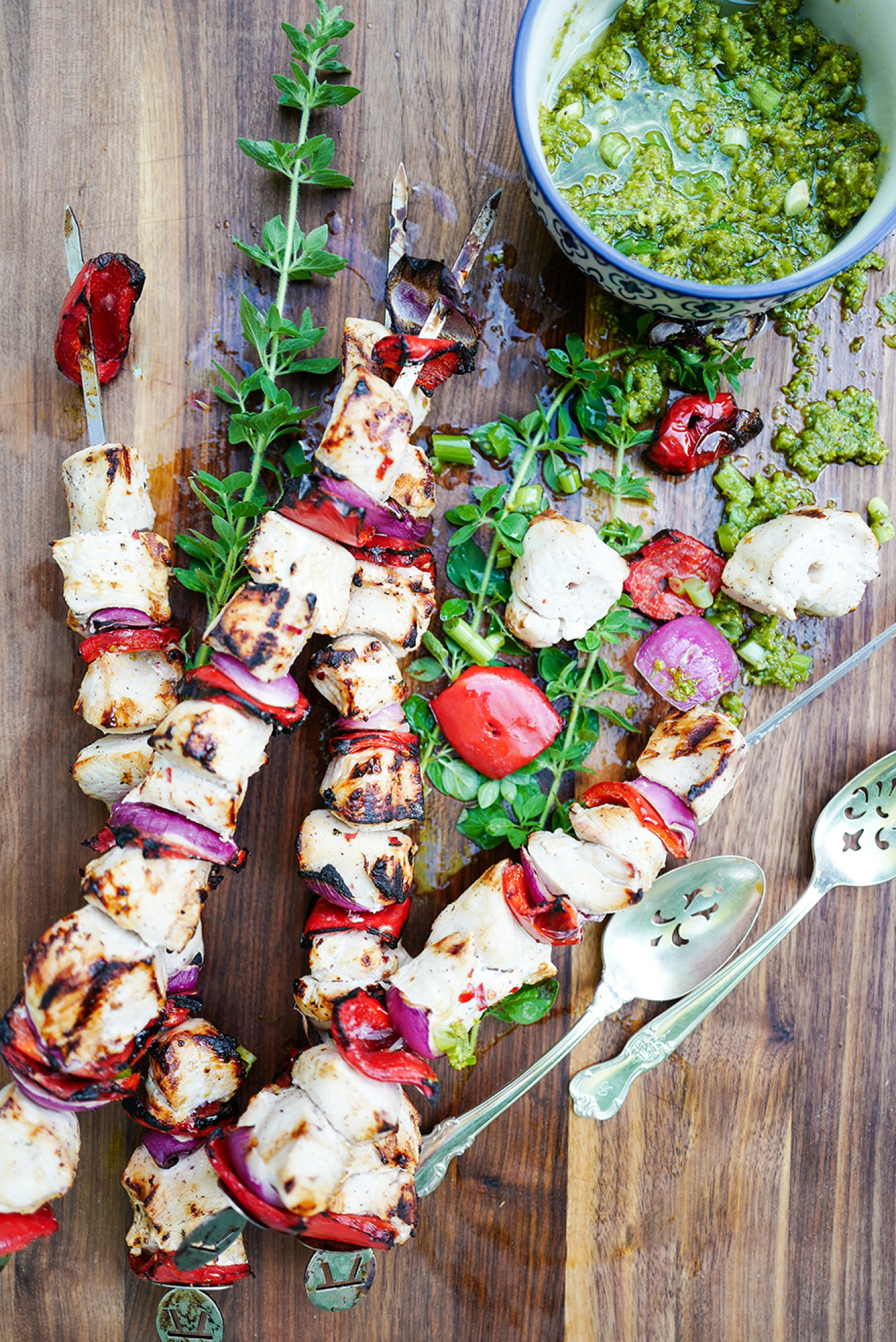
Lamb Shashlyk with Red Wine, Rosemary, & Chives
Ingredients
- 3 lbs. (1.5 kilos) lamb, shoulder or leg, cut into 2-inch (5 cm) chunks
- 3 cups (700 ml) red wine
- ⅓ cup (80 ml) red wine vinegar
- ⅓ cup (80 ml) olive oil
- 3 Tbsp salt
- 1 large yellow onion, thinly sliced
- 2 Tbsp whole coriander seed
- 3 stalks fresh thyme
- 2 stems fresh rosemary
- 2 anchovy fillets
- 6 garlic cloves, peeled and sliced
- One bunch fresh chives, roughly chopped
- Fresh chives and rosemary to garnish
Instructions
- Place the lamb, fresh herbs, onion, anchovy fillets, and garlic in a non-reactive bowl or plastic bag. Whisk together the remaining ingredients, then pour over the meat. Refrigerate for at least 4 hours, ideally overnight. Turn or occasionally stir to ensure that all the meat comes into contact with the marinade.
- Preheat your oven’s broiler to its hottest setting and adjust the rack to the highest level.
- Bring the meat to room temperature, then impale the chunks onto wooden skewers that you have soaked in saltwater.
- Broil the lamb skewers for about 2-3 minutes a side. Tent the meat under foil for 5-15 minutes.
Tangy Rasol and Kefir Chicken Shashlyk
Ingredients
- 3 lbs. (1.5 kilos) boneless chicken thighs cut into 2-inch (5 cm) chunks
- 1 quart (1 liter) kefir or buttermilk
- 2 cups (475 ml) rasol (use a combination of vinegar and lemon juice if you don’t have pickle juice)
- Salt and pepper
- 6 cloves garlic
- 2 tsp. pepper flakes
- Olive oil
Instructions
- Combine the buttermilk, rasol, chopped garlic, and red pepper with a generous pinch of salt and several grinds of the pepper mill.
- Pour the mixture over the chicken into a non-reactive bowl or plastic bag. Refrigerate for at least 2 hours. For best results, leave overnight.
- Preheat your oven’s broiler to its hottest setting and adjust the rack to the highest level.
- Before serving, drain the chicken and pat it dry. Impale the chunks on to wooden skewers. Brush very lightly with olive oil and season with salt and pepper.
- Cook under the pre-heated broiler for about 2-3 minutes per side for 8-9 minutes. Remove from the grill and serve immediately.






